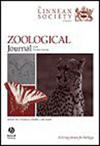中白垩世缅甸琥珀中已灭绝的蝎科Chaerilobuthidae被重新解释为现存的Pseudochactidae亚科(螯角目:蝎类)
IF 2.8
2区 生物学
Q1 ZOOLOGY
引用次数: 0
摘要
缅甸琥珀特有的已灭绝蝎子科Chaerilobuthidae loureno and Beigel, 2011,由于其独特的须足毛体模式,分别与Buthidae C.L. Koch科(1837)和Chaerilidae Pocock科(1893)的A型和B型模式相关而被初步建立。本文描述了中白垩世缅甸琥珀中7种Chaerilobuthidae的11个新标本,利用各种成像技术揭示了它们的形态。根据新发现的甲壳、卵囊、螯足、肢端、毛囊、髋部和腿跗关节的形态学特征,对Chaerilobuthus lourenand Beigel, 2011进行了修订诊断。对Chaerilobuthidae的另外两个属Chaeriloiurus loureno(2020)和serratochoilobuthus loureno(2024)的形态特征进行了重新评价和形态计量学分析,并将其与Chaerilobuthus同名,创建了Chaerilobuthus brigittemuellerae (loureno and Velten, 2020), comb。11 .和Chaerilobuthus schmidti (loureno and Velten, 2024),梳子。11月. .通过对亚洲现存科Pseudochactidae Gromov, 1998的更新形态特征矩阵的系统发育分析,阐明了Chaerilobuthidae的系统地位。系统发育分析将Chaerilobuthidae姐妹归入pseudochactid亚科Vietbocapinae loureno, 2012,证明其转移到Pseudochactidae, as Chaerilobuthinae loureno and Beigel, 2011, stat. 11。这一发现证实了假蝗科的历史可以追溯到100万年前,并有助于了解这一宗教家族的起源和进化史。本文章由计算机程序翻译,如有差异,请以英文原文为准。
Extinct scorpion family Chaerilobuthidae from Mid-Cretaceous Burmese amber reinterpreted as subfamily of extant family Pseudochactidae (Chelicerata: Scorpiones)
The extinct scorpion family Chaerilobuthidae Lourenço and Beigel, 2011, endemic to Burmese amber, was initially established due to its unique pedipalp trichobothrial pattern related to the Type A and Type B patterns of families Buthidae C.L. Koch, 1837 and Chaerilidae Pocock, 1893, respectively. The present contribution describes 11 new specimens, representing seven species of Chaerilobuthidae from Mid-Cretaceous Burmese amber, revealing their morphology using various imaging technologies. A revised diagnosis of Chaerilobuthus Lourenço and Beigel, 2011 is provided based on new morphological characters of the carapace, ocelli, chelicera, pedipalp trichobothria, coxapophyses, and leg tarsi. The other two genera of Chaerilobuthidae, Chaeriloiurus Lourenço, 2020 and Serratochaerilobuthus Lourenço, 2024, are synonymized with Chaerilobuthus based on a reassessment of their morphological characters and morphometric analysis, creating Chaerilobuthus brigittemuellerae (Lourenço and Velten, 2020), comb. nov. and Chaerilobuthus schmidti (Lourenço and Velten, 2024), comb. nov.. The systematic position of Chaerilobuthidae is clarified based on phylogenetic analyses of an updated morphological character matrix for Pseudochactidae Gromov, 1998, an extant family in Asia. Phylogenetic analysis placed Chaerilobuthidae sister to the pseudochactid subfamily Vietbocapinae Lourenço, 2012, justifying its transfer to Pseudochactidae, as Chaerilobuthinae Lourenço and Beigel, 2011, stat. nov.. This discovery confirms that Pseudochactidae date back 100 Mya and contributes to understanding the origin and evolutionary history of this relictual family.
求助全文
通过发布文献求助,成功后即可免费获取论文全文。
去求助
来源期刊
CiteScore
6.50
自引率
10.70%
发文量
116
审稿时长
6-12 weeks
期刊介绍:
The Zoological Journal of the Linnean Society publishes papers on systematic and evolutionary zoology and comparative, functional and other studies where relevant to these areas. Studies of extinct as well as living animals are included. Reviews are also published; these may be invited by the Editorial Board, but uninvited reviews may also be considered. The Zoological Journal also has a wide circulation amongst zoologists and although narrowly specialized papers are not excluded, potential authors should bear that readership in mind.

 求助内容:
求助内容: 应助结果提醒方式:
应助结果提醒方式:


